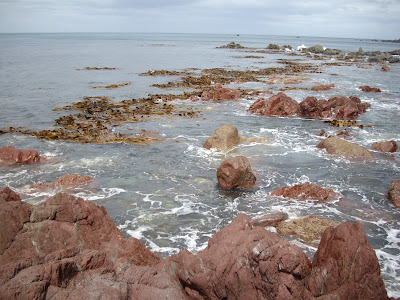It's Kristen, here. Here's a rundown of my job and the mental health climate in NZ from my perspective. I am on a Crisis Assessment and Treatment Team (CATT). The CAT Team provides a regional mental health service (so, covering from downtown Wellington to towns about 30-40km up the west coast). We are based in a town (Porirua) central to the overall catchment area. The team consists of two 9-5 / M-F team leaders / schedulers, two 9-5 / M-F doctors, and then the first line clinicians who are a mix of nurses and social workers who work in 12 hour shifts, two on and three off. The essential function of the team is to assess all patients in crisis (including children / adolescents) on a 24/7 basis, treat if needed, and then dispo them appropriately.
Referrals come in as self-referrals, from family members or friends, general practitioners (GPs), police, EDs, and sometimes from an inpatient medical ward. Referrals from family members are generally what you would imagine: "my 16 year old just left the house against my will with her boyfriend" and "my husband started drinking again and I don't know where he is" and "my friend has been getting more and more depressed and I think she might hurt herself." Routine stuff with routine advise given: call the police or go to the ED if an emergency, mobilze supports and problem solve otherwise. Referrals from police, ED, inpatient ward are generally more severe: many serious overdose attempts, for example. But, most of these folks get sent home with supports (i.e., NOT hospitalized). This is in marked contrast to the States, obviously. There is a huge emphasis on keeping people connected with their family / friends and not relying on institutions. (Interestingly, we see relatively few personality disorders. It's hard to tell if this is a function of the system -- few hospitalizations, reliance on social not institutional supports, separate personality disorders consult team -- or of the Kiwi personality which is very mild and modest).
There are several options for psychiatry support in the community as well. The CAT Team will follow folks for several weeks if needed -- calling at home to check on patients / families, going to get patients for appointments, etc. There is also a Home Based Treatment Team that serves as an alternative to hospitalization. They will see people daily (more if needed) in their home to assess. There are respite facilities which are homes in the community where up to four patients can stay for 3-4 nights while in crisis. These homes are staffed 24 / 7. And, there is an Acute Day Service which is like day treatment for people who are in crisis. So, as an alternative to hospitalization, someone might stay at a respite facility at night, go to an day service during the day, and be followed by Home Based Treatment.
So, what I do is assess folks with both the CAT Team and HBT Team for safety / disposition and medication management. I end up seeing folks all over town in all sorts of settings. Nothing too acute, generally, but certainly an interesting variety.
A note regarding commitment: The process is called the Mental Health Act here. Criteria are similar but terms run from 5 days for initial assessment then 14 days for continued evaluation then in 6 month increments from there. An interesting difference is that when someone is under the Mental Health Act they are mandated to get treatment which includes medications (i.e., there is no separate process for forced meds).
A note regarding medications: Lots of the same medications here (and, drug reps here as well), but some of the medications they don't have are Lexapro, Wellbutrin, Remeron, Librium. They do have an oral MAO inhibitor which is A selective meaning that you don't have to follow dietary restrictions.
That's about it for now. I'll let Richard describe the inpatient setting. I can't leave without saying this though: They came on the unit to have the patients vote, here. It nearly made be cry.
 Cat and Vasha joined us, and Patrick graciously ran us through a crash course in "painting 101" before unleashing us on the canvas.
Cat and Vasha joined us, and Patrick graciously ran us through a crash course in "painting 101" before unleashing us on the canvas.















 A few kilometers back up the road are the Putangirua Pinnacles, a sort of mini-badlands formed over millenia of erosion. For those who are fans of the Lord of the Rings films, this was the setting for the Dimwalt Road which Aragorn, Gimli and Legolas take to summon the dead army as Mordor's armies lay siege to Gondor (Return of the King). The gorge itself is quite difficult terrain, and nearly impossible to photograph with any sense of scale. In the movie, the camera reels up the pinnacles or is set above them looking down into the dry river bed.
A few kilometers back up the road are the Putangirua Pinnacles, a sort of mini-badlands formed over millenia of erosion. For those who are fans of the Lord of the Rings films, this was the setting for the Dimwalt Road which Aragorn, Gimli and Legolas take to summon the dead army as Mordor's armies lay siege to Gondor (Return of the King). The gorge itself is quite difficult terrain, and nearly impossible to photograph with any sense of scale. In the movie, the camera reels up the pinnacles or is set above them looking down into the dry river bed.














